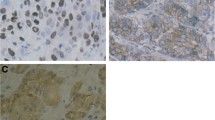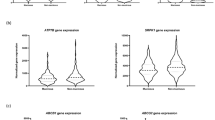Abstract
To determine the clinical significance of MRP in patients with colorectal carcinomas, we have studied the expression of the MRP gene by reverse transcription-polymerase chain reaction (RT-PCR) (n = 105) and by immunohistochemistry (n = 30). MRP mRNA expression was observed in 92 (88%) tumour specimens. Positive MRP staining with monoclonal antibodies QCRL-1 and QCRL-3 was detected in all samples studied with strong staining in seven (23%) and weak staining in 23 (77%) specimens. Strong MRP staining in these samples did not appear to be related to the age and sex of the patients, localization of the primary tumour, histological grade, tumour size, lymph node metastasis, distant metastasis and tumour stage. Strong MRP staining was not associated with MDR1 RNA or P-glycoprotein (P-gp) expression. Kaplan-Meier curves revealed that overall survival of patients with strong MRP-staining tumours was similar to the survival of patients with weak-staining tumours. These data indicate that the MRP gene is expressed in primary colorectal carcinomas but is neither related to known prognostic factors nor a prognostic factor by itself.
Similar content being viewed by others
Author information
Authors and Affiliations
Rights and permissions
About this article
Cite this article
Fillpits, M., Suchomel, R., Dekan, G. et al. Expression of the multidrug resistance-associated protein (MRP) gene in colorectal carcinomas. Br J Cancer 75, 208–212 (1997). https://doi.org/10.1038/bjc.1997.35
Issue Date:
DOI: https://doi.org/10.1038/bjc.1997.35
- Springer Nature Limited
This article is cited by
-
Decreased functional activity of multidrug resistance protein in primary colorectal cancer
Diagnostic Pathology (2015)
-
Portrait of multifaceted transporter, the multidrug resistance-associated protein 1 (MRP1/ABCC1)
Pflügers Archiv - European Journal of Physiology (2007)
-
Cytotoxicity of rhein, the active metabolite of sennoside laxatives, is reduced by multidrug resistance-associated protein 1
British Journal of Cancer (2002)
-
Tyrosinase-related protein 2 as a mediator of melanoma specific resistance to cis-diamminedichloroplatinum(II): therapeutic implications
Oncogene (2000)




